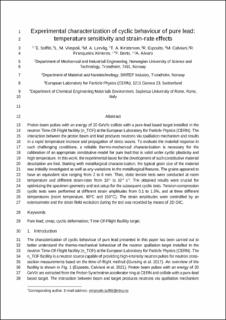| dc.contributor.author | Solfiti, Emanuele | |
| dc.contributor.author | Viespoli, Luigi Mario | |
| dc.contributor.author | Lervåg, Malin | |
| dc.contributor.author | Kristensen, Tore Andre | |
| dc.contributor.author | Esposito, Raffaele | |
| dc.contributor.author | Calviani, Marco | |
| dc.contributor.author | Ximenes, Rui | |
| dc.contributor.author | Berto, Filippo | |
| dc.contributor.author | Alvaro, Antonio | |
| dc.date.accessioned | 2023-05-02T15:57:16Z | |
| dc.date.available | 2023-05-02T15:57:16Z | |
| dc.date.created | 2023-04-23T15:34:55Z | |
| dc.date.issued | 2023 | |
| dc.identifier.citation | Materials Science & Engineering: A. 2023, 874, 145082. | en_US |
| dc.identifier.issn | 0921-5093 | |
| dc.identifier.uri | https://hdl.handle.net/11250/3065850 | |
| dc.description.abstract | Proton beam pulses with an energy of 20 GeV/c collide with a pure-lead based target installed in the neutron Time-Of-Flight facility (n_TOF) at the European Laboratory for Particle Physics (CERN). The interaction between the proton beam and lead produces neutrons via spallation mechanism and results in a rapid temperature increase and propagation of stress waves. To evaluate the material response in such challenging conditions, a reliable thermo-mechanical characterization is necessary for the calibration of an appropriate constitutive model for pure lead that is valid under cyclic plasticity and high temperature. In this work, the experimental bases for the development of such constitutive material description are lied. Starting with metallurgical characterization, the typical grain size of the material was initially investigated as well as any variations in the metallurgical features. The grains appeared to have an equivalent size ranging from 2 to 6 mm. Then, static tensile tests were conducted at room temperature and different strain-rates from 10−1 to 10−4 s−1. The obtained results were crucial for optimizing the specimen geometry and test setup for the subsequent cyclic tests. Tension-compression cyclic tests were performed at different strain amplitudes from 0.1 to 1.5%, and at three different temperatures (room temperature, 90 °C and 150 °C). The strain amplitudes were controlled by an extensometer and the strain field evolution during the test was recorded by means of 2D DIC. | en_US |
| dc.language.iso | eng | en_US |
| dc.publisher | Elsevier | en_US |
| dc.title | Experimental characterization of cyclic behaviour of pure lead: temperature sensitivity and strain-rate effects | en_US |
| dc.title.alternative | Experimental characterization of cyclic behaviour of pure lead: temperature sensitivity and strain-rate effects | en_US |
| dc.type | Peer reviewed | en_US |
| dc.type | Journal article | en_US |
| dc.description.version | acceptedVersion | en_US |
| dc.rights.holder | © 2023 The authors | en_US |
| dc.source.volume | 874 | en_US |
| dc.source.journal | Materials Science & Engineering: A | en_US |
| dc.identifier.doi | 10.1016/j.msea.2023.145082 | |
| dc.identifier.cristin | 2142672 | |
| dc.source.articlenumber | 145082 | en_US |
| cristin.ispublished | false | |
| cristin.fulltext | preprint | |
| cristin.qualitycode | 2 | |
